 For our 25th birthday, we’re looking at Google by the numbers — 25 of them, to be exact.
For our 25th birthday, we’re looking at Google by the numbers — 25 of them, to be exact.
Google at 25: By the numbers
 For our 25th birthday, we’re looking at Google by the numbers — 25 of them, to be exact.
For our 25th birthday, we’re looking at Google by the numbers — 25 of them, to be exact.
 For our 25th birthday, we’re looking at Google by the numbers — 25 of them, to be exact.
For our 25th birthday, we’re looking at Google by the numbers — 25 of them, to be exact.
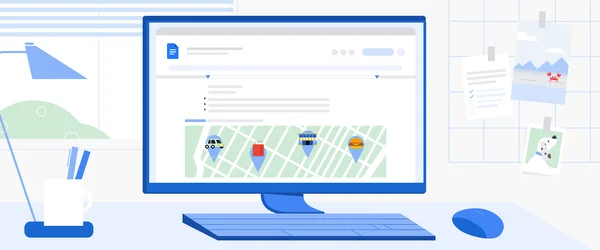 With Google Docs’ pageless format, you can write uninterrupted.
With Google Docs’ pageless format, you can write uninterrupted.
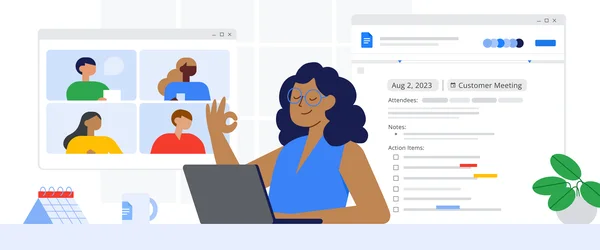 This quick tip can help you get set up a meeting notes template in no time.
This quick tip can help you get set up a meeting notes template in no time.
 Try out these Google products to make wedding planning a little easier.
Try out these Google products to make wedding planning a little easier.
A self-described “marketer by day, women’s advocate by night,” Nyamekye Nti has built her career around storytelling for good. “I craft stories and narratives about Google products, and those skills help me craft stories to advocate for women,” she says.
When she’s not marketing Google Cloud products, Nyamekye is running Yielding Accomplished African Women (YaaW), a nonprofit dedicated to building the largest online career community of Black college women in science, technology, engineering and math (STEM). Since its launch in 2018, YaaW has trained more than 1,000 women in 12 African countries and certified more than 750 African women through accelerator programs, STEM “sororities” and groundbreaking conferences sponsored by Google and others. And while originally focused on Africa, YaaW is quickly going global.
Fresh off her win as Africa Tech Festival’s 2021 Female Innovator of the Year, we spoke with Nyamekye about her passion for representation in STEM and what advice she has for fellow entrepreneurs.
How would you describe your job at Google to someone who doesn’t work in tech?
I’m a marketing strategist at Google, meaning I find ways to explain to Fortune 500 companies how Google Cloud can help them. I do that through customer testimonials, stories, blogs and events.
What inspired you to get involved in STEM representation?
I’m an alumni of several leadership development programs. They inspired me to believe and bet on myself, and that really catapulted my entire college and corporate career. I was able to work at the best of the best companies, because these programs gave me the skills, attitude and connections to succeed. I knew I had to bring this specifically to Black women. Because as much as I loved those experiences, I still felt there were gender-specific gaps in skill-development training. Those gaps led me to start Yielding Accomplished African Women (YaaW).
Tell us more about why you started YaaW.
Forty percent of Black college students switch out of STEM majors because they don’t believe they can actually finish these degrees. They don’t have the support they need. And many times, even when they do complete it, they don’t have access to recruiters and companies to set them up for career success. As a Black woman who studied STEM and went into finance, I understand this fight. And what we want to do at YaaW is ensure that the path is easy for anyone.
In 2019, YaaW hosted the Women in Machine Learning Conferencein Ghana. What was that experience like?
This was the first machine learning conference in Africa specifically for women. It was a three-day event filled with sisterhood, personal development, professional development and a lot of heavy training. We even brought in three women machine learning engineers from Google.
You founded YaaW at just 21 years old. What advice do you have for other young women who want to start their own businesses?
Research. But go beyond just your business model and quantitative analysis. What in history can give you secrets for the future? When I was in college, I was just gleaning from history — from philosophers and sociologists who wrote things hundreds of years ago that we still stand on today. If you’re building something, research who’s done it extremely well. You’d be surprised by how much you can learn from them.
Who’s an inspirational woman in your own life?
My grandmother. She was illiterate, never went to school and worked on a farm all her life. She made a choice to make sure all of her children were educated — and this was in the 60s, in Ghana, as a poor woman. Now we have doctors and lawyers — and people giving interviews like this! — in the family. This year, YaaW is establishing a million-dollar scholarship program for Black college women in her name.
Ever wonder what your dog is thinking? You’re not alone. Over the last year, dog “talking” buttons have taken the pet world by storm. With the push — er paw — of a button, dogs are now “telling” their humans what they need, whether that’s water, food or to go outside. Some pups have even become social media famous for their impressive vocabulary, inspiring dog owners everywhere to pick up a set of buttons. Or in the case of Rutledge Chin Feman, a software engineer for Google Nest, to try building their own DIY versions.
“I know I’m biased, but Cosmo is obviously the best dog in the world,” says Rutledge of his pup. When he and his wife adopted Cosmo, a German Shepherd mix and the first dog for both of them, they noticed right away he was skittish. “He was afraid of everything and would do a lot of lunging and barking. It was kind of a forcing function to learn a lot about positive reinforcement training techniques and desensitization…which is how I stumbled on all of this.”
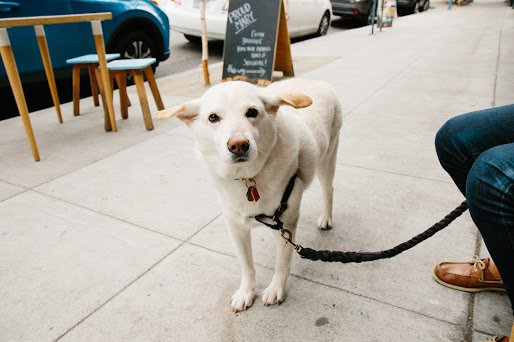
After Rutledge saw a video of dog-talking buttons that blew his mind, he started to build his own set for Cosmo — the perfect hobby to blend his passions for engineering and animals.
He used an electronics prototyping board (a “breadboard”) to hold the buttons, and a small computer (a “Raspberry Pi”) to activate them with light, sound and notifications. The first model, made from a wooden wine box, had just three buttons: “food,” “water” and “outside,” which Rutledge recorded with his own voice. Now, Cosmo’s up to seven buttons — with “ball,” “later,” “love you” and “scritches” (otherwise known as “belly rubs”) added to the mix.
At one point, Rutledge even set the board up so that he received text messages whenever Cosmo pressed a button. “I’ve been in meetings where I’m like, ‘Hold on a sec, I need to silence my phone. My dog is blowing me up right now.’”
Rutledge and his wife will add a “baby” button to Cosmo’s board next, now that their newest family member has arrived. And the wheels are already turning for Rutledge: “I think it will only be a few months before a baby could push buttons and say things — ask for more food or whatever. I think that will be a fun experiment.”
For now, he’s focused on Cosmo and continuing to strengthen their bond using the button board. “I think it’s a really powerful way to see your pet. It really reminds you that they’re intelligent beings who are capable of profound thought, in a way. And they’re constantly observing their world in a way that we don’t usually really give them credit for.”
“It’s a really simple device, it’s all just for fun,” he adds of the process. “And obviously, Cosmo’s a very good boy.”
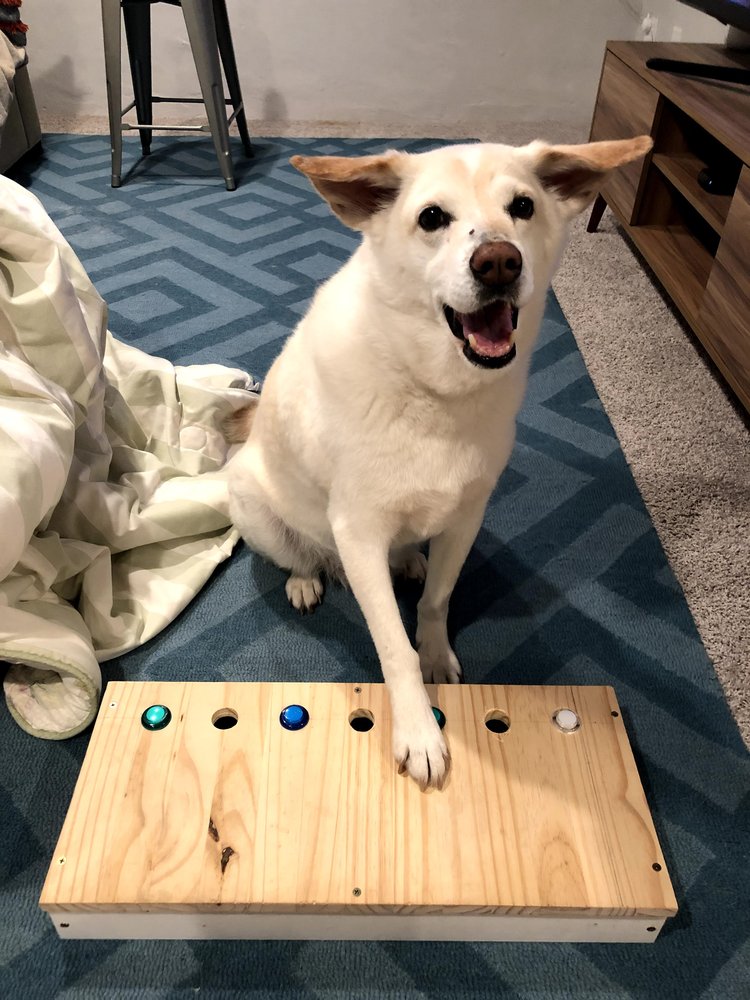
I’m always looking for ways to be more sustainable. And with the holidays in full swing, when many of us (✋) are particularly overindulgent, it’s a fitting time to start eco-friendlier traditions.
Here are a few ways you can embrace more green this holiday season, with help from Google.
Traveling for the holidays this year? It’s easy to find more sustainable ways to get where you’re going. Google Flights now shows estimated carbon emissions for every flight. And if you’re hitting the road, Google Maps lets you choose the most fuel-efficient driving route if it’s not already the fastest one. If you also need a place to crash (other than your parents’ house), a quick Google search for hotels will show you information about their sustainability efforts.

Look up estimated carbon emissions on Google Flights.
It’s tempting to keep the living room holiday lights on all night — not only because they’re festive, but so you can avoid the tangled wires to turn them off. If you connect them to your Google Nest or Home speaker or display using a compatible smart plug, you can easily turn them off with your voice, conserving energy for both you and the planet. You can also set up a Routine so they automatically turn on and off at a specific time every day. While you’re at it, save even more energy with a Home & Away Routine for your Nest thermostat to automatically adjust the heat at different points of the day, including when you’re out of the house.
After the holidays, many of us are faced with mountains of boxes, wrapping paper and, oh yes, a tree. You may also need to make space for new gifts — like the Pixel 6 or Pixel 6 Pro? ? — that are replacing old gadgets. By viewing Business Profiles on Google Maps and Search, you can see where to recycle or properly dispose of certain materials so they don’t end up in landfills. If you’re looking to recycle an old Google device or other electronics you're no longer using, check out our mail-in program.
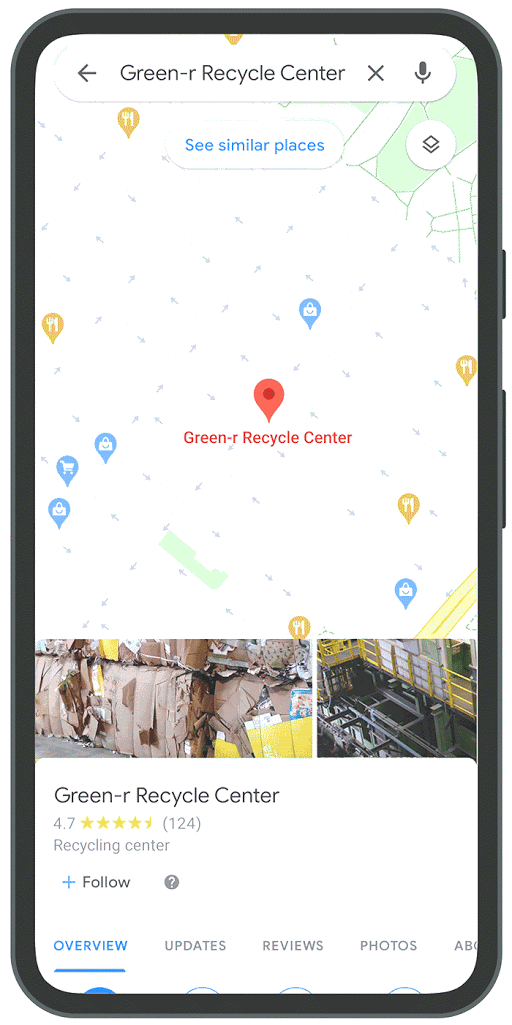
Check out Business Profiles on Google Maps and Search to see where (and what) to recycle.
The Food at Google team, who keeps our global offices’ kitchens running and operating sustainably, shared some tips for cooking responsibly this holiday season:
Consider also donating any non-perishable foods you don’t use to a food bank or pantry. In the U.S., you can search for “food pantry near me” to quickly find verified locations across the country.
Yousuf Fauzan’s mother knew she’d be on the phone a lot this October. Every day during the month, she’d talk to her son for hours as he paced around his home in California. “She would get irritated, she would disconnect the call, then I’d call again 15 minutes later.”
Calling his mom — and pretty much everyone he knows — was how Yousuf, a YouTube software engineer, passed the time while getting his steps in for “Walktober,” Google’s annual employee walking competition. “I don’t talk to people on the phone often, but during October, I call anyone and everyone I’ve ever known.” After spending his workday walking during meetings, Yousuf would lap around the inside of his condo from 7:00 p.m. until 4:00 a.m. to hold his top spot on the leaderboard. By the end of the month, he’d accumulated more than two million steps.
Planning lead Tiffany Bartish-Katz says this is the kind of “fierce but friendly” competition that Walktober attracts. Started in 2011 as a local effort in Google’s Cambridge, Massachusetts office, Walktober quickly went global: This year, more than 26,000 employees across 190 offices joined the competition, putting in over five billion steps. “I’m always a little awestruck by the number of people who engage in this very simple, friendly, fun, grassroots project,” Tiffany says. And the planning team works hard to make sure everyone gets in the spirit — from ultra walkers like Yousuf, to those who are adding just a few more thousand steps to their routines.
Some Walktober participants decided to put their step counts towards a good cause. Last year, Greg Kroleski, a Google Cloud Product Manager, walked for 24 hours straight. As he considered doing another 24-hour challenge this year, a coworker suggested tying it to a fundraiser. “A lot of people paid attention last year. I wanted to direct that attention to something good.” Greg dedicated this year’s challenge, and his team’s entire Walktober effort, to raise awareness for myalgic encephalomyelitis/chronic fatigue syndrome (ME/CF), a chronic disease that causes overwhelming fatigue. He and his colleagues ended up raising $14,000. As for the 24-hour challenge? Greg logged over 204,000 steps that day, breaking a Google Walktober record…for a few hours, at least. “Unfortunately, the next day, someone else broke my record.” All the more reason to give it another go next year. “You might see me again,” he says.
Ziad Reslan, a Product Policy Advisor at Google, also channeled his team’s Walktober efforts towards something good. “I wanted to spend the entire last day of Walktober walking as an ode to the journeys of millions of refugees who have no choice but to walk to get to safety,” he says. To raise awareness for LGBTQ+ refugees in the Middle East in particular, Ziad organized a walk from Google’s San Francisco office to its Mountain View headquarters — a familiar 38.8-mile route for California commuters. He received over $25,000 in pledged donations from fellow Googlers, with a handful joining him throughout the day.
When Ziad and his colleagues reached the Mountain View campus that evening, he was overwhelmed: “I teared up remembering the first time I had ever been [to Mountain View] wishing to become a Googler,” he says. “And now here I was, walking to it surrounded by other Googlers for a good cause.”